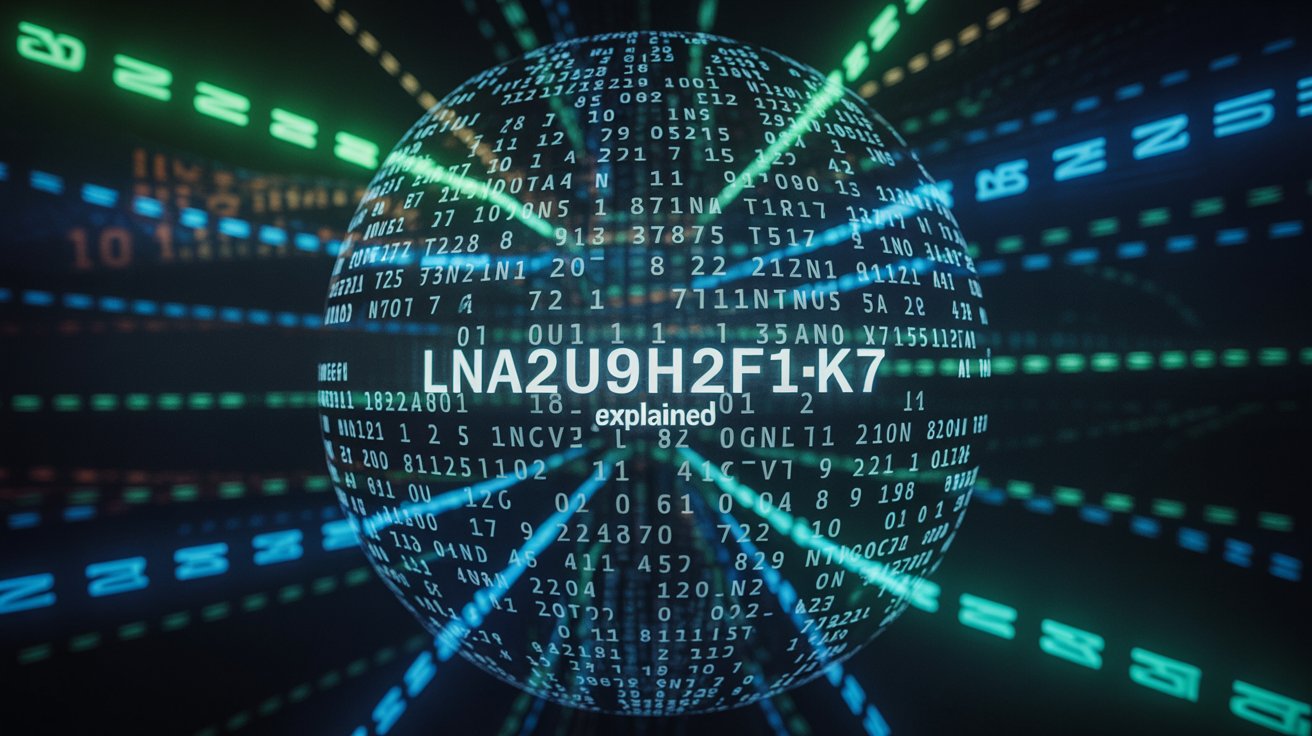LNA2U9H2F1K7: Unveiling the Hidden Meaning, Uses, and Latest Insights Behind This Mysterious Code

In the digital age, mysterious alphanumeric codes like LNA2U9H2F1K7 pop up across various technological landscapes, leaving many people curious about their purpose and significance. Whether you’ve encountered this code in a technical document, system interface, or online discussion, understanding its nature can help demystify the complex world of digital identifiers. This comprehensive guide explores everything you need to know about LNA2U9H2F1K7, from its fundamental structure to its potential applications in modern technology.
What Exactly Is LNA2U9H2F1K7?
LNA2U9H2F1K7 represents a unique alphanumeric identifier composed of 12 characters combining letters and numbers in a specific sequence. This type of code structure follows common patterns used in various digital systems for tracking, identification, and data management purposes. The composition includes uppercase letters (L, N, A, U, H, F, K) and numbers (2, 9, 1, 7), creating a distinctive combination that serves as a unique marker in digital environments. Such identifiers are fundamental to modern computing systems, where millions of items, records, or processes need individual identification to prevent confusion and maintain data integrity.
Understanding the Structure and Format
The format of LNA2U9H2F1K7 follows a specific pattern that isn’t random but likely adheres to a predetermined system design. Alphanumeric codes typically use a combination of characters to maximize the number of possible unique identifiers while keeping the string length manageable. With 12 characters mixing letters and numbers, this code structure can generate billions of unique combinations, making it suitable for large-scale systems requiring extensive tracking capabilities. The absence of special characters and use of only uppercase letters suggests it’s designed for systems where case sensitivity and special character support might cause compatibility issues or where simplicity and readability are prioritized.
Common Applications of Alphanumeric Identifiers
Alphanumeric codes like LNA2U9H2F1K7 serve crucial roles across multiple industries and technological domains. In database management systems, these identifiers act as primary keys that uniquely identify each record, ensuring data accuracy and preventing duplicate entries that could compromise system integrity. Telecommunications networks utilize similar codes for tracking devices, sessions, and transactions across complex infrastructure. Healthcare systems employ alphanumeric identifiers for patient records, medical devices, and pharmaceutical tracking to maintain privacy while enabling efficient data retrieval. Manufacturing and supply chain operations rely on these codes for inventory management, product tracking, and quality control throughout the production lifecycle.
Technical Significance in Digital Systems
From a technical perspective, codes structured like LNA2U9H2F1K7 offer several advantages in system architecture and design. They provide a balance between human readability and machine processing efficiency, making them suitable for both automated systems and situations where manual entry or verification might be necessary. The 12-character length strikes an optimal balance—long enough to ensure uniqueness in large datasets but short enough to be practically manageable. These identifiers often serve as session tokens, API keys, transaction references, or database record pointers, functioning as the backbone of data organization in complex software systems. The specific character combination could encode information about creation date, system origin, or classification category, though this depends entirely on the implementing system’s design.
Potential Use Cases in Modern Technology

could represent lna2u9h2f1k7 various elements in contemporary technological ecosystems. It might function as a hardware component identifier in electronics manufacturing, where each circuit board, sensor, or integrated system receives a unique code for quality assurance and warranty tracking. In software development, such codes frequently serve as version identifiers, build numbers, or commit hashes that help teams track changes and maintain code integrity. Cloud computing platforms use similar alphanumeric strings for resource identification, allowing administrators to manage virtual machines, storage containers, and network configurations. Cryptographic systems might employ these codes as hash representations, digital signatures, or encryption keys that secure sensitive data and communications.
Security and Authentication Implications
Identifiers structured like LNA2U9H2F1K7 play significant roles in security frameworks and authentication protocols. When used as part of security systems, these codes can serve as tokens that verify user identity, grant access permissions, or maintain session integrity across web applications. The seemingly random nature of such codes makes them difficult to guess or predict, adding a layer of security through obscurity when properly implemented. However, security professionals understand that reliance solely on code complexity isn’t sufficient—these identifiers must be combined with proper encryption, secure transmission protocols, and access control mechanisms to truly protect sensitive systems and data.
Data Management and Organization Benefits
Organizations leverage alphanumeric identifiers like LNA2U9H2F1K7 to create sophisticated data management frameworks. These codes enable efficient indexing and retrieval operations in databases containing millions or billions of records, where human-readable names would be impractical or insufficient for unique identification. The standardized format facilitates automated processing, allowing systems to validate, sort, and cross-reference information without manual intervention. In data migration and integration projects, these unique identifiers serve as critical anchors that maintain record relationships even when data moves between different systems or platforms. The consistency in format also simplifies backup and recovery operations, ensuring data integrity during system maintenance or disaster recovery scenarios.
Industry-Specific Applications and Standards
Different industries have developed standardized approaches to alphanumeric identification that codes like LNA2U9H2F1K7 might align with. The financial sector employs transaction identifiers and account numbers with similar structures to track billions of daily transactions across global networks. Logistics companies use tracking codes that follow comparable patterns for package and shipment management throughout complex delivery networks. The pharmaceutical industry relies on serialization codes to combat counterfeiting and ensure drug safety from manufacturing to patient delivery. Automotive manufacturers assign vehicle identification numbers and part numbers that share structural similarities, enabling precise tracking of components and vehicles throughout their lifecycle.
The Role in IoT and Connected Devices
As the Internet of Things continues expanding, codes like LNA2U9H2F1K7 become increasingly important for managing vast networks of connected devices. Each smart sensor, wearable device, or industrial monitor requires unique identification to communicate effectively within IoT ecosystems. These identifiers enable device authentication, data routing, and network management in environments where millions of devices might operate simultaneously. Smart home systems, industrial automation platforms, and smart city infrastructure all depend on robust identification schemes to coordinate activities, process data streams, and maintain security across distributed networks. The scalability offered by well-designed alphanumeric codes makes them ideal for IoT applications expected to grow exponentially in coming years.
Challenges and Limitations
Despite their utility, alphanumeric identifiers like LNA2U9H2F1K7 present certain challenges in practical implementation. Human error during manual entry remains a persistent issue, especially with codes lacking obvious patterns or checksum digits for validation. The absence of semantic meaning makes these codes difficult for people to remember or communicate verbally, potentially creating inefficiencies in workflows requiring human interaction. Storage and indexing of massive quantities of these identifiers can strain database performance if not properly optimized. Additionally, privacy concerns arise when identifiers become associated with sensitive personal information, requiring careful handling to comply with data protection regulations and maintain user trust.
Best Practices for Implementation
Organizations implementing systems using identifiers like LNA2U9H2F1K7 should follow established best practices to maximize effectiveness and minimize problems. Developing clear documentation about identifier structure, purpose, and usage guidelines helps teams understand and properly utilize these codes. Implementing validation mechanisms that check format compliance and detect common entry errors improves data quality and system reliability. Maintaining secure generation processes ensures identifiers remain unique and difficult to predict or forge. Regular audits of identifier usage patterns can reveal inefficiencies or security vulnerabilities requiring attention. Organizations should also plan for long-term scalability, ensuring their identification schemes can accommodate growth without requiring disruptive system overhauls.
Future Trends and Evolution
The landscape of digital identification continues evolving as technology advances and new requirements emerge. Machine learning algorithms increasingly interact with these identifiers, using pattern recognition to detect anomalies, predict system behaviors, and optimize operations. Blockchain technology introduces new approaches to distributed identification that might supplement or transform traditional alphanumeric codes. Quantum computing’s emergence may eventually necessitate more complex identification schemes as current cryptographic assumptions face new challenges. The growing emphasis on interoperability between systems and platforms drives standardization efforts that could influence how future identifiers are structured and implemented across industries.
Decoding the Mystery: What We Can Learn
While the specific purpose of LNA2U9H2F1K7 might remain context-dependent without additional information, understanding the broader landscape of alphanumeric identifiers provides valuable insights into modern digital infrastructure. These codes represent more than random character strings—they’re fundamental building blocks enabling the complex, interconnected systems that power contemporary technology. Whether serving as database keys, device identifiers, security tokens, or tracking codes, alphanumeric identifiers like LNA2U9H2F1K7 exemplify how simple concepts scale to solve sophisticated problems in an increasingly digital world.
Practical Implications for Users and Professionals
For professionals working with technical systems, encountering codes like LNA2U9H2F1K7 requires understanding their context and proper handling procedures. Developers should implement robust identifier management in applications, ensuring codes are generated securely, stored efficiently, and validated correctly. Database administrators must optimize indexing strategies for identifier-based queries while maintaining data integrity across system operations. Security professionals need to assess whether identifiers might expose sensitive information or create vulnerabilities requiring mitigation. End users benefit from understanding that these codes serve important purposes even when their specific meanings aren’t immediately apparent, enabling more informed interactions with the systems they use daily.
Conclusion: The Hidden Order Behind the Code
LNA2U9H2F1K7 and similar alphanumeric identifiers represent the hidden order underlying our digital world. These codes enable systems to manage complexity, maintain accuracy, and provide services at scales unimaginable without such identification mechanisms. While they may appear mysterious at first glance, understanding their structure, purpose, and implementation reveals the thoughtful engineering behind modern technology infrastructure. As our world becomes increasingly digital and interconnected, the importance of robust, scalable identification systems will only grow, making codes like LNA2U9H2F1K7 essential components of our technological future. Whether you’re a developer, system administrator, or curious observer, appreciating the role these identifiers play helps demystify the complex systems shaping our daily lives.



